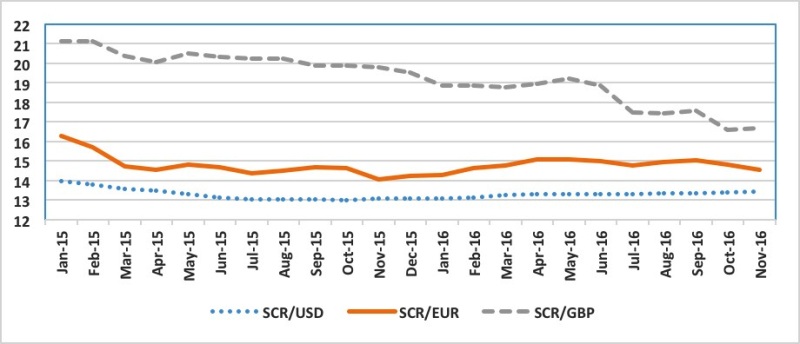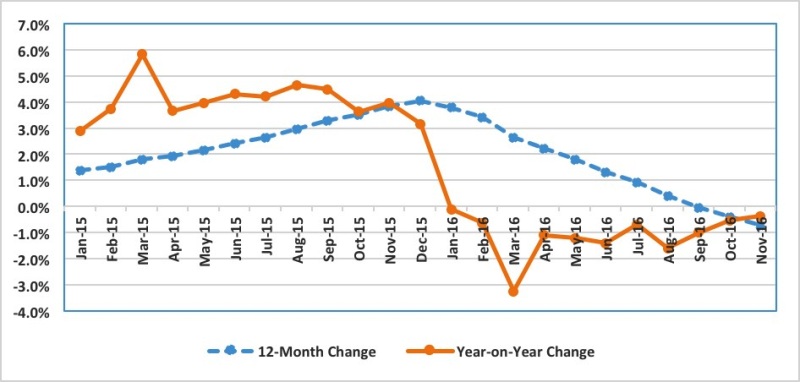2016: The Seychelles economy achieved positive growth |30 December 2016
END-OF-YEAR ISSUE
• Managed to build further resilience against future potential economic headwinds
In the midst of widespread degree of uncertainty surrounding the global economic environment, notwithstanding Seychelles’ high reliance on the rest of the world, the country’s economy was able to show further signs of resilience during 2016.
All indications are that Seychelles will record another year of positive expansion in output although the expectation is that such growth would be at a reduced pace compared to the outcome achieved in the previous year. Based on latest projections, real GDP would grow by 4.4% in 2016, compared to 5.7% in 2015.
Tourism remained a key driver of growth in consideration of the sector’s contribution to GDP, foreign exchange earnings and employment generation. By mid-December 2016, the year-to-date number of tourists to Seychelles was 10% higher than the corresponding period last year as well as above the cumulative figure for 2015 as a whole. Therefore, while growth in visitor arrivals is not expected to reach the 19% level achieved in 2015, the annual increase in the number of tourists to the country is anticipated to remain strong in 2016. Consistent with the established trend, the majority of these tourists originated from Europe with France representing the main supplier by country. To note, of increased importance are the contributions from the emerging markets of Asia and the Middle East.
The growth in visitor arrivals in 2016 however did not translate into a corresponding increase in yield, a situation being given attention by the relevant authorities. Nonetheless, from a contraction of 1.3% in tourism earnings in 2015 in US dollar terms, the direct contribution of income from the sector to foreign exchange inflows is estimated at US $422 million or at 7.6% higher than in the previous year.
Consistently, total inflows of foreign exchange into the Seychelles economy during 2016 has been higher than in 2015. However, a relative stronger increase in demand has been observed. It follows that while the average value of the rupee has remained broadly stable against its main trading partners, it depreciated vis-à-vis the US dollar, particularly in periods when demand tended to pick up. By mid-December 2016, the Seychelles rupee has weakened by 16 cents (1.2 per cent) relative to the US dollar compared to its end December 2015 value. Nonetheless, the notable exchange rate movement in 2016 was the appreciation of the domestic currency by around two rupees against the British pound, an outcome attributed to a weakening of the pound internationally, triggered in June by the result of the referendum in favour of the United Kingdom to exit from the European Union.
Chart 01: Exchange Rates(SCR per currency, period average)

On the inflation front, a development with strong correlation to movements in exchange rates, the monthly consumer price index (CPI) published by the National Bureau of Statistics showed somewhat benign inflationary pressures throughout the year. The rate of inflation is expected to end 2016 at close to zero percent, an outcome particularly supported by low or falling prices of commodities in international markets.
Chart 02: Consumer Price Index (Measure of Inflation)

Partly due to the afore-mentioned weak international commodity prices and therefore the associated reduction in the value of some imported items – including mineral fuels – as well as growth in export earnings, the country’s external position has improved in 2016. Such development is reflected through a narrowing of the current account deficit measured as a percentage of GDP. Additionally, gross official reserves have increased from US $536 million at the end of 2015 to US $543 million in mid-December 2016, with the latter position equivalent to just above 4 months of import cover.
Monetary statistics showed an expansion in liquidity, supported by an increase in domestic credit. Notable was the growth in credit to the private sector. In November 2016, the year-on-year increase in outstanding credit to the private sector was by 9.9%, attributed primarily to outstanding loans disbursed to the categories private households, manufacturing, wholesale and retail sectors as well as mortgage loans. Recent developments have shown a faster increase in loans to finance consumptions compared to credit disbursed to the productive sectors.
As regards to interest rates, the average effective lending rate stood at 12.36% in November 2016 and lower than the 12.68% figure for the same month of 2015. Consistently, the savings rate has declined to 2.87% from 2.90% over the same period leading to a reduction in the interest rate spread from 9.78% to 9.49%. There was also an overall fall in the yield on short-term government securities with that for the 91-day maturity falling from 6.89% to 5.22% while the average return on fixed-term rupee deposits declined from 4.28% to 3.48% over the same period.
Another notable development was the government’s decision to introduce measures aimed at reducing poverty which, based on the outcome of a recent study, has found to be on the high side. Among the steps taken were some measures to improve disposable income at the lower end of the salary scale. One of which was an increase in the minimum wage as well as aligning such wage level to the amount paid as old age pension effective April. As from that month, there was also the introduction of the first phase of a progressive income tax system.
Throughout the year, the Seychelles’ authorities remained committed to the successful implementation of the three-year arrangement with the International Monetary Fund (IMF) under the Extended Fund Facility (EFF) approved by the IMF executive board in June 2014. Two key targets set out under the programme, namely the primary fiscal surplus and a minimum level of net international reserves were successfully achieved. In addition, government remained on target to reduce total public debt down to 50% of GDP by 2020.
Going forward, the resilient of the Seychelles economy is expected to be tested further. This takes into consideration both domestic and external developments. The impact on the Seychelles economy of the expected revision in trade agreements between the US and its key trade partners to be spearheaded by the new US president as well as the outcome of unfolded negotiations under Brexit remained uncertain. A peak-up in commodity prices including that of oil points to higher inflationary risks in 2017. Such threat to the general price level would increase if the depreciation of the domestic currency is sustained, an outcome that would be inevitable if growth in demand remained persistently stronger than supply. The fiscal measures introduced to increase disposable income are expected to boost aggregate demand which given the country’s high reliance on imports could put pressure on balance of payments if not supported by the right policy mix. Nonetheless, the economy is projected to grow by around 4% in 2017, supported by another positive performance of the tourism sector which is anticipated to benefit from an increase in visitor arrivals, mainly attributed to the improved air access.
Contributed




